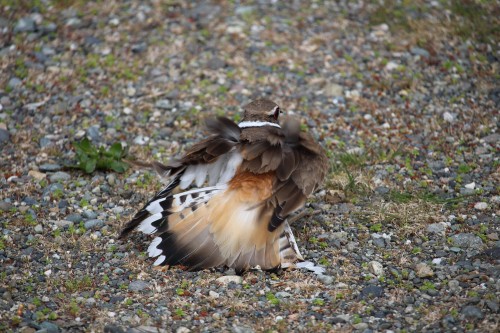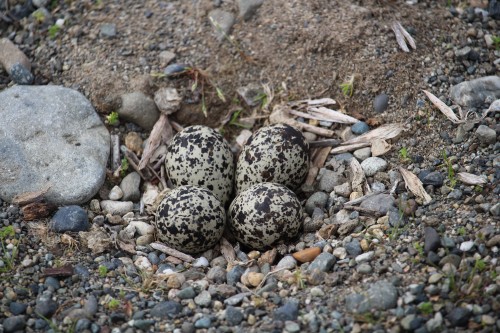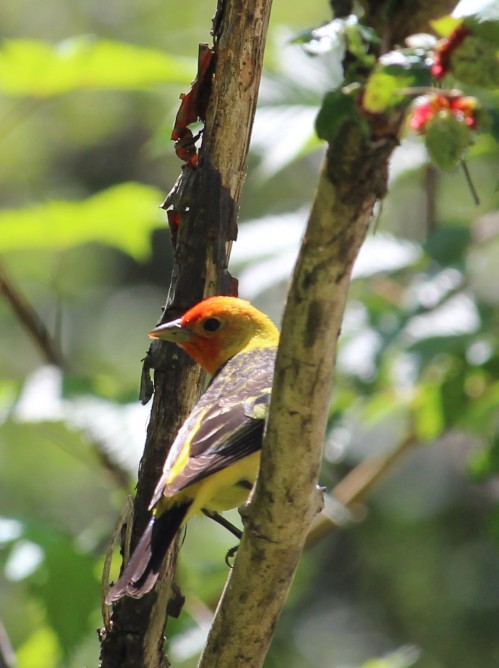I will GET loud!”
— Robert Downey Jr. channeling Alfre Woodard or a killdeer in Heart and Souls
A killdeer is a small nervous bird with long legs and red irises whose call is a high, piercing stutter. I photographed one a couple months ago while walking in the state park at lunch. At the time, I didn’t know much about killdeers and honestly, I wasn’t interested in them as much as I was some of the other birds I was getting to know, especially the waterfowl.

Killdeer at Lake Sammamish State Park.
But another birder I met at the park one day pointed out a place on the beach just a few feet off the walking path where a killdeer had made her nest. I hadn’t even noticed, even though I walk by there every day. The bird was away at the moment and a single egg lay in a little scoop in the ground. It was the 30th of March.
When I was able to return three days later I came back with my camera and found the killdeer sitting on the nest, blending so well with the surroundings that I might again have missed her if I didn’t know where to look for her. She didn’t stir until I got a little too close in my effort to photograph her. Then she hopped up and ran away from the nest, calling in a high, twittery, broken sounding way, and I was able to see that there were not one but three eggs now.

Baby killdeers disguised as pebbles.
A few yards away, the bird did this strange, beautiful thing: she put her wings out partway, scraped her belly on the ground and lowered her tailfeathers so that the vivid brown color of her inner feathers could be seen. She put her tail at an angle as if it were broken and shook herself, continuing to call out loudly.

The gimpy act.
Her cry, if I might be so bold to interpret for her, said “Come and get me. I’m wounded, an easy kill, a plump dinner right here for the taking.” It was her attempt to draw attention away from her eggs. I’d heard of this behavior in quail many years ago but never seen any bird actually performing this act. I left her alone and wandered off, noting however that she quickly regained her composure, tiptoed back to the nest and lay over the eggs again.
I walked down the beach to where a woman with a camera was taking photos of some mergansers while her dog snuffled around offleash — an infraction of park rules carrying an $80 fine. I didn’t congratulate the woman about her being special and the rules not applying to her because I’ve been special in other ways at other times (cf. stone, casting first), but I did hope that she was not heading down to the end of the beach where the killdeer’s nest was. My hope was in vain. I watched her wander down the beach and, though it was now far away, I could see that the woman’s big fluffy hound was trotting across the area where the nest was, and not directly across but in that doggish back-and-forth way that seemed at this moment optimally suited to covering the most ground and assuring the accidental destruction of small eggs underfoot.

You can be a few yards away and not even see her sitting there.
A park employee in big green raingear was doing some work up ahead and I stopped and told her how bummed I was that special people were letting their dogs run free against park rules when there was a killdeer who was trying to raise a family out there. The lady signaled sympathy with my dismay about Specials, but was even more interested in the killdeer nest and wanted me to show her where it was.
I hesitated, mumbling that I had to get back to my office — true, this — but she said “we can take the Gator”. She hopped onto the little green park vehicle — basically a golf cart with a flatbed for rakes and shovels. I couldn’t resist.
We sputtered across the park with a small breeze beating against our faces, and I showed her the nest. She stood a shovel up in the gravel a yard or so away to identify the spot and said she’d have her supervisor help her mark it so the lawnmower guy wouldn’t mow it (apparently they mow the gravel beach). She said the killdeers were some of her favorites but their numbers are dwindling in the park (right, I thought, because they aren’t smart enough to build their nests away from foot traffic), and with a sad expression noted that between the seagulls and the crows and the raptors (eagles, hawks, what have you), she didn’t think the eggs stood much of a chance.

No dogs allowed. If you look closely you can see her sitting in the Safe Zone.
On April 6th I found the nest surrounded by a neat rectangle of cones and tape. The mama bird, looking now a bit like an art exhibit, again dashed away shrieking to draw me off after she became convinced that lying still and quiet on the nest was not having the effect that she was hoping for. But she didn’t go far this time. She put on the same display and again got loud, but stayed close. I quickly turned to the nest to try to fire off a quick shot — four eggs now! — and when I did so she turned toward me and gave me a beak lashing. Really, she told me all about it. When I turned back to regard her she immediately turned away and started limping and fluttering again and her voice went weak and tremulous.

Four!
I turned to the nest again and took my shot, and she practically charged me. I half expected her to kick me in my toe. I took an out-of-focus shot of her reading me the Riot Act before she quickly turned away from me again to shiver and shriek her staccato plaint.
“Okay, sweetheart,” I said. “Okay, I’m goin’.” I didn’t want to cause her any more stress. It couldn’t be good for her.

Cue the Hitchcockian bird-attack music. She ran at me so fast I couldn’t even focus.
On April 9 as I was walking toward the little coned-off square it occurred to me I should probably name her, since she had become a little story for me, and the name Selma came to mind. But when I got closer I could see that the killdeer was not on her nest. I looked past the cones and found the nest empty. Absolutely empty. I wondered what this could mean. If there were broken eggs I would know that marauders had attacked before the chicks had hatched. If there were pieces of eggshell I would surmise that the chicks had hatched, although I would think it odd that they were gone. Maybe I would think they hatched and were plucked up immediately by predators, but I might also hope that Selma had marched them off to the safer area of vegetation beside the creek, even though it seemed that less-than-a-day-old chicks would not yet be able to waddle or even see.
But the total absence of the eggs pointed almost to removal by human hands. Or theft? Who would do that and why would they do it? It would certainly mean death to the chicks and eventually, rotten eggs that would be too smelly for an egg collection. Did they cook and eat them?

The site of probably tragedy.
I saw the park worker some days later and asked if she knew what had happened. She said it was most likely seagulls or even the Canada geese that are hanging out at the park these days, even though there were no shell fragments. I was mildly crestfallen. I thought the mama bird was the bravest little life in the world, pretending to be wounded and putting herself in danger’s path in order to give her babies a chance at survival, and I was sad to think her nesting dreams had foundered. What would she do for the rest of the spring? Would she and her mate split up, turn to drink and gambling?
The woman said, however, that a few killdeer pairs were nesting “over in the boneyard”, a clearing in the woods where park employees dump old tree trunks that are in the way of paths or otherwise pose a danger — (most snags are left standing for habitat and after they fall are left lying for forest health), and that if I wanted to see more nests I should go there.
I did and I did. Just last week, I finally visited the boneyard and sure enough, the moment I walked into the clearing there were two killdeers trying to give me the runaround, one faking the broken wing and making a lot of noise. I thought I was smarter than they were and looked for their nest — carefully, look before each step! — in the area where I first spotted them, opposite from where they were trying to lead me. But it turns out that at least in this location they actually don’t spend much time at the nest. When I finally found it — by pretending to leave the clearing and then watching through my binoculars to see where one of them eventually went and settled down — it turned out to be well away from where I had first seen them. Canny buggers. There were four eggs, and these had a slightly different pattern from those in the first nest. They had more of the light-green hue, with larger but fewer dark speckles.

A new batch.
I’ve since learned that four is a plenary session for killdeer eggs, and once the fourth is laid the sitting starts in earnest, so this little quartet are on their way. I also read that killdeer chicks are precocial (yes, the word is related to “precocious”), meaning that they exhibit a high degree of independence very early. They can see when they’re born and walk almost immediately. Being hatched in unfeathered divots in parking lots and on open beaches, it makes sense that they would be up and about toot sweet, not waiting around the nest to have breakfast regurgitated at them (altricial) or be snatched up by a gull.
Sunlight and rain fall equally on the evil and the good, so the master said. Nor are there any guarantees for little birds using whatever wits their maker gave them to keep the tribe going, except that they shall not fall unregarded. But hope seems wondrously unteachable, both in birds and men. I returned again this week and the eggs were still there. 
——————————————–
Update 5/5/15: I only just published this post this morning, but already there is more to tell. During my lunch walk today I happened upon the park employee — she’s actually a volunteer — doing some work up ahead on the path, but some yards beyond where I would be turning off. I almost didn’t bother to take the extra steps and disturb her, but I figured she would be happy to know that I’d found one of the killdeer nests back in the boneyard. When I told her this she was thrilled and asked me again if I would point it out to her.
This time I didn’t hesitate, but hopped aboard as she shipped her tools and fired up the Gator. Her name is Pat, I learned after introducing myself, and she has been worried to pieces about those birds back in the boneyard. She hadn’t seen the nest, but she knew there must be at least one because of the presence and behavior of the adults, and that clearing is frequently subject to the ravages of tractors that the park employees use to push stumps and piles of brush and other deadfall around in it. Pat had prevailed upon the park administrators to impose a two-week moratorium on any tractor work back there, but in that time she had not been able to locate any nests and in fact the two weeks was up today. One of the park employees, says Pat, has found her eagerness to inconvenience park operations on behalf of a mob of little chirpers more than a little irritating (“he thinks I take it too far,” she said), and she had had to overcome loud objections in order to win the reprieve. My news today came just in time.
I don’t know what my fellow employees thought, several of whom were also out walking in pairs or singly, when they saw me with my blue Blunt umbrella riding shotgun on the state park’s maintenance vehicle next to a state park volunteer, but it didn’t matter.
“We’re on a quest, Matt,” said Pat, leaning over the wheel as if this would make the cart go faster.
“That’s right, Pat,” I returned, indulging in a wide grin.

In the boneyard. Volunteer Pat indicates the nest, near the end of the bleached branch that’s sticking out of the ground.
She stopped to grab a tall orange “cone” and throw it on the cart, for marking the nest. She said that now that the spot is identified, the employees can continue their work away from the nest and yet the eggs will be safe. (At least from humans. Predation is still a threat; a hawk circled over the boneyard as we set the cone near the nest.) It’s a comfort to me to know I’m not the only one who worries about the little things that don’t fit into this consumptive, twittering age’s idea of value. Is it just another one of the many eternal mysteries, then, that our Father in heaven simultaneously ordains by supreme fiat each avian death and seeds the breast of folks like Pat, and like me, with an impulse to strive beyond comfort and reason against that ordinance? And is that little ridiculous place in the human heart in fact the tiny nest of God’s own love?





























